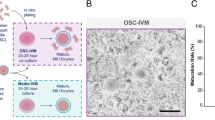Abstract
We aim to understand how oocyte vitrification impacts subsequent mouse preimplantation embryo development at molecular level. We profiled transcriptomics of fertilized preimplantation embryos derived from mouse vitrified-warmed oocytes. Concomitantly, we evaluated epigenetic markers in fertilized preimplantation embryos. We found that oocyte vitrification did not affect the fertilization and cleavage process but delayed embryo development until blastocyst stage. RNA sequencing revealed that 1575 genes were profoundly altered in the 2-cell stage embryos developed from vitrified oocytes. The most significantly altered biological pathway was “oxidation-reduction process.” Such profound transcriptomics change was associated with decreased level of oocyte-specific histone H1FOO in zygote and 2-cell stage. Transcriptome alteration due to oocyte vitrification was less pronounced as embryos develop into the morula stage. Oocyte vitrification temporarily changes transcriptomics in early preimplantation embryos. Targeting oxidation-reduction pathway might be a potential therapeutic strategy to improve embryo quality and long-term embryo survival.




Similar content being viewed by others
Abbreviations
- IVF:
-
in vitro fertilization
- MII:
-
metaphase II
- FPKM:
-
Fragments per Kilobase Million
- DEGs:
-
different expression genes
- ZGA:
-
zygotic genome activation
- GO:
-
Gene Ontology
- COCs:
-
cumulus-oocyte complexes
References
Cobo A, Diaz C. Clinical application of oocyte vitrification: a systematic review and meta-analysis of randomized controlled trials. Fertil Steril. 2011;96(2):277–85.
Kuwayama M. Highly efficient vitrification for cryopreservation of human oocytes and embryos: the Cryotop method. Theriogenology. 2007;67(1):73–80.
De Munck N, Vajta G. Safety and efficiency of oocyte vitrification. Cryobiology. 2017;78:119–27.
Practice Committees of American Society for Reproductive M. Society for assisted reproductive T. Mature oocyte cryopreservation: a guideline. Fertil Steril. 2013;99(1):37–43.
Chen H, Zhang L, Deng T, Zou P, Wang Y, Quan F, et al. Effects of oocyte vitrification on epigenetic status in early bovine embryos. Theriogenology. 2016;86(3):868–78.
Ziegenhain C, Vieth B, Parekh S, Reinius B, Guillaumet-Adkins A, Smets M, et al. Comparative analysis of single-cell RNA sequencing methods. Mol Cell. 2017;65(4):631–43 e634.
Urbanska K, Orzechowski A. Unappreciated role of LDHA and LDHB to control apoptosis and autophagy in tumor cells. Int J Mol Sci. 2019;20(9).
Brigelius-Flohe R, Maiorino M. Glutathione peroxidases. Biochim Biophys Acta. 2013;1830(5):3289–303.
Suo L, Meng Q, Pei Y, Fu X, Wang Y, Bunch TD, et al. Effect of cryopreservation on acetylation patterns of lysine 12 of histone H4 (acH4K12) in mouse oocytes and zygotes. J Assist Reprod Genet. 2010;27(12):735–41.
Kim JM, Liu H, Tazaki M, Nagata M, Aoki F. Changes in histone acetylation during mouse oocyte meiosis. J Cell Biol. 2003;162(1):37–46.
Lin Q, Inselman A, Han X, Xu H, Zhang W, Handel MA, et al. Reductions in linker histone levels are tolerated in developing spermatocytes but cause changes in specific gene expression. J Biol Chem. 2004;279(22):23525–35.
Hayakawa K, Ohgane J, Tanaka S, Yagi S, Shiota K. Oocyte-specific linker histone H1foo is an epigenomic modulator that decondenses chromatin and impairs pluripotency. Epigenetics. 2012;7(9):1029–36.
Tanaka M, Hennebold JD, Macfarlane J, Adashi EY. A mammalian oocyte-specific linker histone gene H1oo: homology with the genes for the oocyte-specific cleavage stage histone (cs-H1) of sea urchin and the B4/H1M histone of the frog. Development. 2001;128(5):655–64.
Tanaka M, Kihara M, Hennebold JD, Eppig JJ, Viveiros MM, Emery BR, et al. H1FOO is coupled to the initiation of oocytic growth. Biol Reprod. 2005;72(1):135–42.
Sun Y, Gu R, Lu X, Zhao S, Feng Y. Vitrification of in vitro matured oocytes diminishes embryo development potential before but not after embryo genomic activation. J Assist Reprod Genet. 2016;33(2):231–6.
Cobo A, Kuwayama M, Perez S, Ruiz A, Pellicer A, Remohi J. Comparison of concomitant outcome achieved with fresh and cryopreserved donor oocytes vitrified by the Cryotop method. Fertil Steril. 2008;89(6):1657–64.
Cobo A, Coello A, Remohi J, Serrano J, de Los Santos JM, Meseguer M. Effect of oocyte vitrification on embryo quality: time-lapse analysis and morphokinetic evaluation. Fertil Steril. 2017;108(3):491–7 e493.
Jansen RP, de Boer K. The bottleneck: mitochondrial imperatives in oogenesis and ovarian follicular fate. Mol Cell Endocrinol. 1998;145(1–2):81–8.
Rienzi L, Gracia C, Maggiulli R, LaBarbera AR, Kaser DJ, Ubaldi FM, et al. Oocyte, embryo and blastocyst cryopreservation in ART: systematic review and meta-analysis comparing slow-freezing versus vitrification to produce evidence for the development of global guidance. Hum Reprod Update. 2017;23(2):139–55.
Matilla E, Martin-Cano FE, Gonzalez-Fernandez L, Sanchez-Margallo FM, Alvarez IS, Macias-Garcia B. N-acetylcysteine addition after vitrification improves oocyte mitochondrial polarization status and the quality of embryos derived from vitrified murine oocytes. BMC Vet Res. 2019;15(1):31.
Li Z, Gu R, Lu X, Zhao S, Feng Y, Sun Y. Preincubation with glutathione ethyl ester improves the developmental competence of vitrified mouse oocytes. J Assist Reprod Genet. 2018;35(7):1169–78.
Funding
This research is supported by (1) the National Natural Science Foundation of China (Funding No. 81601342). (2) Shanghai Municipal Planning Commission of Science and Research Fund (General Program, No. 201740075)
Author information
Authors and Affiliations
Corresponding authors
Ethics declarations
All animal experiments were performed following the ethical guidelines of Obstetrics & Gynecology Hospital, Fudan University, and the Animal Ethics Committee approved this project.
Additional information
Publisher’s Note
Springer Nature remains neutral with regard to jurisdictional claims in published maps and institutional affiliations.
Electronic Supplementary Material
Supplemental Figure 1
A. Violin plot for log2(FPKM+1) of all genes across all samples, showing the boxplot of normalized FPKMs across all the samples. B. Spearman correlation coefficiency (SCC) of gene log2(FPKM+1) for paired samples. C. The PCA score plot (PC2 vs. PC3). (PDF 1212 kb)
ESM 1
(DOCX 16 kb)
ESM 2
(XLSX 17 kb)
Rights and permissions
About this article
Cite this article
Ruihuan, G., Zhichao, L., Song, G. et al. Oocyte Vitrification Temporarily Turns on Oxidation-Reduction Process Genes in Mouse Preimplantation Embryos. Reprod. Sci. 28, 1307–1315 (2021). https://doi.org/10.1007/s43032-020-00337-w
Received:
Accepted:
Published:
Issue Date:
DOI: https://doi.org/10.1007/s43032-020-00337-w




